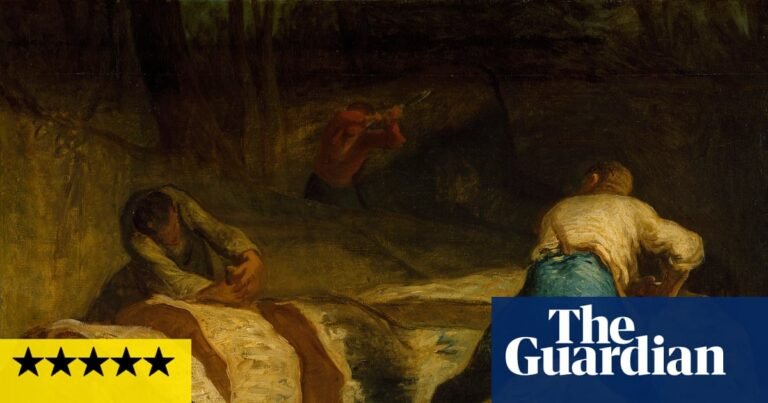The figures in Jean-François Millet’s 1859 painting The Angelus, a French icon that’s come to the UK on loan from the Musée d’Orsay in Paris, seem extremely odd on close inspection. Their faces are obscure, their bodies intriguing under their shapeless work clothes. What age are they? How are they related? The man is quite young, his top shirt button loose, although his legs are as stiff as a doll’s, inside thick, rough-cut trousers. It’s harder to tell the woman’s age because she stands in profile, a breeze pressing her heavy skirt against her legs, as she clasps her hands. They might be a married couple or, as this painting’s unlikely fan Salvador Dalí claimed, mother and son. Their physicality is intense. The phallic prongs of a thick wooden potato fork and wheelbarrow shafts add to the feeling that, now the working day is done and they’re saying their prayers, they can finally get to bed. But if they’re mother and son? I refer you to Dr Dalí.
Hello Dalí … detail from The Angelus by Millet Jean-François. Photograph: Jean-François Millet/© Musée d’Orsay, Dist. Grand Palais Rmn / Patrice Schmidt
I think there’s a reason Millet makes The Angelus not so much a religious as an erotic landscape. It was the climax of his love affair with the French peasantry. Millet made it his life’s work to portray the rural poor – a class that had been denied full humanity. He depicts lives of backbreaking toil but wants you to see that, behind the hoe, is a human being with a mind, a body, desires.
Stark existential moments … The sower by Jean-François Millet. Photograph: © Amgueddfa Cymru – National Museum Wales
Landscape artists often can’t draw the human figure for toffee: that means you, Constable and Turner. But Millet foregrounds the body in stark existential moments of sweaty action. Work that in reality must have been repetitive and mindless becomes full of heroic drama. In The Winnower, a man throws grains in the air in a golden mist to separate the wheat from the chaff. Painted at the time of the 1848 revolutions, when liberal and socialist risings were shaking the wheat from the chaff across Europe, the winnower is, you realise, wearing a reddish-pink bandana, a white shirt and has a blue handkerchief – the colours of the tricolour flag that the first French Revolution invented.
Millet’s a revolutionary and his people have plenty to rebel against. In The Sower, a man is sowing seeds in a deep gully: it looks as if he has descended into hell. This pit looks completely barren yet here he is, sowing seeds anyway, the symbolism as hard to ignore as the arses of the two cows that loom against the stormy sky above him. His act may be that of a political campaigner, sowing seeds of change, yet it’s also an image of artistic creativity. The character could be Millet himself, creating something beautiful out of the brutal realities of rural toil.
His autobiography is compacted into this small show. Millet was a country boy from Normandy. His painting The Well at Gruchy captures the world he grew up in – a woman fills pots of water from a stone-roofed well that appears to be centuries old. Life is slow there, in Gruchy, and history a massive, immobile presence. The Faggot Gatherers, which Millet was working on up to 1875, looks like a riposte to the impressionists’ emphasis on modernity and middle-class pleasures on boulevards and in cafes. Women lug bundles of sticks through Stygian winter gloom in a scene that could just as easily have been in the 1370s as the 1870s.
Silent passions … The Goose Girl at Gruchy by Jean-François Millet. Photograph: © Amgueddfa Cymru – National Museum Wales
He found one fan looking desperately for soul in the world. Vincent van Gogh wanted to emulate Millet as a peasant painter. You see their deep connection in Millet’s drawing A Man Ploughing and Another Sowing. As the broken-looking sower stumbles in the foreground and a ploughman hunches behind him, a flock of black crows rise into the sky – like the birds Van Gogh would see over the wheatfield near the end of his life.
Yet for all his brooding compassion, you can’t miss Millet’s turbulent sexuality. The two athletic men in his painting The Wood Sawyers look as if they are cutting up a giant penis. Then again, the slices of trunk also resemble freshly butchered meat – another one for Dalí. More conventionally sexualised are Millet’s portraits of shepherdesses and milkmaids. His painting The Goose Girl at Gruchy may be as much a memory of adolescent longings as a painting from life. Van Gogh in a frenzied letter claims Millet’s women are as sexy as Zola’s – you can see how he got to this and how much Millet’s fascination with the silent passions of country people has in common with Thomas Hardy’s novels.
It all comes together in The Angelus, which you keep coming back to after scanning his other works. The scene it immortalises is ancient, the lives these people lived largely lost to history. Millet freezes them like statues. They grow like grass from the hard earth that can’t wait to take them back.
Millet: Life on the Land is at the National Gallery, London, from 7 August to 19 October
